Abstract
Hybrid nanofluid is considered a new type of nanofluid and is further used to increase the heat transfer efficiency. This paper explores the two-dimensional steady axisymmetric boundary layer which contains water (base fluid) and two different nanoparticles to form a hybrid nanofluid over a permeable moving plate. The plate is suspected to move to the free stream in the similar or opposite direction. Similarity transformation is introduced in order to convert the nonlinear partial differential equation of the governing equation into a system of ordinary differential equations (ODEs). Then, the ODEs are solved using bvp4c in MATLAB 2019a software. The mathematical hybrid nanofluid and boundary conditions under the effect of suction, S, and the concentration of nanoparticles, (Al2O3) and (TiO2) are taken into account. Numerical results are graphically described for the skin friction coefficient, , and local Nusselt number, , as well as velocity and temperature profiles. The results showed that duality occurs when the plate and the free stream travel in the opposite direction. The range of dual solutions expand widely for S and closely reduce for . Thus, a stability analysis is performed. The first solution is stable and realizable compared to the second solution. The and increase with the increment of S. It is also noted that the increase of leads to an increase in and decrease in .
1. Introduction
In recent decades, study of fluid dynamics has received significant interest among researchers, scientists and scholars from different fields due to various applications in engineering, science and technology. The most commonly pursued topics relate to the boundary layer flow. According to Buseman [1], Ludwig Prandtl was the pioneer in providing a boundary layer theory. Using his theory, numerous researchers have successfully conducted in analyzing different types of fluid: Newtonian or non-Newtonian fluid with various effect and surfaces. In 2004, a group of researchers lead by Duwairi et al. [2] investigated the effect on heat transfer of an unsteady squeezing and extrusion of a viscous fluid over two parallel plates. It was found that increasing the squeezing parameters resulting in increased heat transmission and decreased local friction factor, while the extrusion parameter reduced heat transfer levels and increased the skin friction factor. Later, Arifuzzaman et al. [3] examined the effect of large suction over an upright plate on heat and mass transfer. The study showed that the velocity and temperature profile increased with the increased of suction. Next, Liu et al. [4] numerically inspected the power law in fluids. Further readings on viscous fluid can be found in the studies by Anyanwu et al. [5], Vankateswarlu et al. [6] and Raju et al. [7].
Demand for compact electronic components and devices has grown rapidly, hence requiring more effective thermal conductivity compared to the basic fluid. Thermal conductivity plays a substantial role on the heat transfer coefficient occurring between the medium and the surface. Scientists and technologists found a new class of fluid known as nanofluid. The term nanofluid has been proposed, as micromillimeter-sized particles are suspended in traditional heat transfer basic fluid (Kakaç and Pramuanjaroenkij [8]). Thus, the thermal conductivity of nanofluid is predicted to augment heat transfer compared with regular heat transfer fluid (Masuda et al. [9]). Choi [10] proposed the term nanofluid in explaining the suspension of the solid nanoparticles in basic fluid. Choi et al. [11] added that through his investigation, the addition of nanoparticles enhances the thermal conductivity. Long et al. [12] examined stagnation point flow over a stretching/shrinking sheet of nanofluid. Next, Mohyud-Din et al. [13] expanded the idea of nanofluid over two rotating parallel plates by taking consideration of the effects of heat and mass transfer. Then, Zhu et al. [14] investigated the explicit analytical solution of two-dimensional laminar flow and heat transfer of nanofluids through the microchannel with nonlinear velocity slip and temperature. Later, Bakar et al. [15] carried out the work on nanofluid over a stretching/shrinking cylindrical shape. Furthermore, numerous studies have been conducted in highlighting the novelty of nanofluid by taking consideration of various effects, physical properties, surfaces and shapes. Collections on nanofluid articles can be seen in Mishra et al. [16], Prasad et al. [17], Farooq et al. [18], and He et al. [19].
The first person to study the action of the boundary layer on a continuously solid surfaces was Sakiadis [20]. He found that the behavior for that respected surface and the behavior of the boundary layer in a fluid flowing over a smooth, stable, flat surface considered by Blasius [21] was significantly different. In addition, Tsou et al. [22] made an experimental and theoretical treatment of the boundary layer flow on a continuously moving surface. They concluded that measurements of the laminar velocity field are in excellent agreement with the analytical predictions. Investigation of thermal transport in a non-Newtonian fluid was done by Tsai and Hsu [23]. They reported that both flow and thermal fields are significantly affected by the power law index, n, and generalized Prandtl number. In the presence of thermal radiation, the reduction in thermal boundary thickness of the plate is due to the effect of the Prandtl number, which was studied by Bataller [24] on the traditional Blasius flow in fluid mechanics. Next, Haile and Shankar [25] highlighted the presence of thermal radiation, viscous dissipation and chemical reaction. Throughout their study, the temperature profile was increased by viscous dissipation, thermal radiance, Brownian motion and thermophoresis, whilst the Prandtl number and velocity parameter made a substantial reduction. In addition, the thermophoresis parameter was found to enhance the concentration profile but contradict with the other parameters involved in their study. Maliki et al. [26] scrutinized the fluid flow pseudoplastic nanofluid with viscous dissipation and heat absorption/generation. In their study, four nanoparticles were dispersed in sodium carboxymethyl cellulose/water to investigate the behavior of Newtonian and pseudo-plastic non-Newtonian fluids.
Adding effects to the flow are important in order to analyze whether the effect helps in giving positive significance for the flow. One effect often examined by researchers is suction. Suction is a way to control the boundary layers, and aims at reducing friction in external flows or reducing energy losses in the channels. In other word, it is a means of preventing or slowing down boundary layer separation. In order to implement the effect of suction, one should ensure that the surface should contain holes, gaps, openings, porous parts or perforations. These ducts are used to suck the area of the boundary layer which is closest to the wall and travels at the lowest speed. Consequently, the boundary layer velocity profile becomes occupied and stable as far as separation is concerned. Hartnett [27] had recognized the significance of suction or injection for the boundary layer control in his work. It is often necessary to quickly impede separation of the boundary layer in order to reduce drag and achieve high elevation values. In spite of this, suction/injection of fluid through the surface can significantly modify the flow field, such as in mass transfer cooling. Moreover, it affects the rate of heat transfer in forced, free and mixed convection. Due to this impressive idea, several researchers have taken part in studies of the effect of suction. The contribution of the effect of suction on various surfaces and types of fluid has been considered by Masad et al. [28], Rosali et al. [29], Pandey and Kumar [30], Subammowo et al. [31], Lund et al. [32], and Kausar et al. [33].
Recently, technologists have determined the existence of an interesting advanced nanofluid known as hybrid nanofluid. It was expected to have elasticities of higher thermal conductivity compared to those of ordinary fluid and nanofluid. The hybrid nanofluid term is envisioned to define a combination of superior characteristics at an affordable cost for two or more different types of dispersed nanoparticles within the base fluid. Olatundun and Makinde [34] studied Blasius flow over a convectively heated surface. In their study, five different geometries of nanoparticles shapes—spherical, bricks, cylindrical, platelets and blades—were also taken into account. They solved the problem numerically using the shooting method coupled with Runge–Kutta–Fehlberg numerical scheme. The result shows that the temperature increment and Nusselt number are highest for spherical and blade shapes, respectively, compared to the others. Waini et al. [35] investigated the flow in a permeable stretching/shrinking sheet with radiation effect. Their findings reveal that a duality of solutions exists. In addition, the effect of radiation thickens the thermal boundary layer for dual solutions.
Motivated by the documented literature review stated above, this work aims to analyze numerically the two-dimensional steady laminar flow and heat transfer on a moving plate over hybrid nanofluid in the presence of suction.
2. Description of Flow Problem
In this paper, we consider our problem as a two-dimensional steady axisymmetric boundary layer of a hybrid nanofluid past a permeable plate moving in a uniformly free flow, U. We assumed that the hybrid nanofluid is in thermal equilibrium and no slip conditions exist. In this system, the fluid flow occurs at where the x-axis is aligned to the plate’s surface while the y-axis is the coordinate measured normal to it. It is assumed that the temperature, T, at the plate takes constant values Tw, and the value the for temperature in ambient fluid is T∞. Meanwhile, the ambient fluid velocity of the plate is expected to be , where is the parameter for plate velocity (Bachok et al. [36]). Additionally, we also took into account the effect of suction, S, as illustrated in Figure 1. We chose two different nanoparticles: Al2O3 and TiO2 with water base fluid. The nanoparticles are assumed to have a uniform spherical shape and size. The hybrid nanofluid’s thermophysical attributes are given in Table 1.
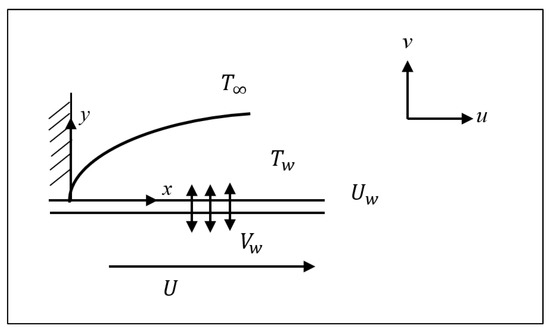
Figure 1.
Schematic view of the problem geometry model.

Table 1.
Base fluid and nanoparticle numerical values for thermophysical properties (Ahmed and Mimi [37]).
The steady flow governing equations are constructed by following the previous readings [36]:
related to the following boundary conditions (BCs);
where and are constants. Furthermore, the component of velocity for x axes and y axes are u and v, respectively. The thermal diffusivity of the hybrid nanofluid is , while and are the density and viscosity of hybrid nanofluid, respectively. Moreover, S is the non-dimensionless parameter which determine the transpiration rate with suction or injection . Following Oztop and Abu Nada [38] and Devi and Devi [39], a set of thermophysical properties is simplified in Table 2. The hybrid nanofluid is set up by mixing the nanoparticles TiO2 into 0.1 volume of Al2O3/water to form the appropriate hybrid nanofluid. In this study, a 0.1 volume of Al2O3 is added constantly to the water throughout while various volumes of solid fraction of TiO2 are added to produce Al2O3-TiO2/water.

Table 2.
Hybrid nanofluid’s thermophysical properties.
Throughout Table 2, we note that the subscripts of hnf, nf and f represent hybrid nanofluids, nanofluids and fluids, respectively. Further, and represent two different nanoparticles of solid volume fractions, where represents Al2O3 and represents TiO2. In addition, represents the density, is specific heat at constant pressure and is thermal conductivity, where s1 indicates Al2O3 and s2 TiO2 nanoparticles.
To solve the boundary layer equations, we introduced a stream function, , where and , to derive a similarity solution of Equations (1)–(3) which resulted in Equation (1) being satisfied identically. We obtain the similarity transformations:
Invoking Equation (5) into Equations (2)–(3), we obtain the reduction of momentum and energy equations in the following form:
along the BCs:
where , , and are viscosity, density, thermal conductivity and specific heat for base fluid (water), respectively. Furthermore, is the Prandtl number. The physical quantities of interest in this study are the skin friction coefficient, Cf, and local Nusselt number, Nux, which are respectively defined as:
is the skin friction and is the heat flux from the plate, given by:
Substituting Equation (10) into Equation (9), we have:
where .
3. Stability Solution
A stability analysis is carried out to identify which of these solutions are stable. To initiate a stability analysis, according to Weidman [40], the unsteady state flow case must be included to study the temporal stability of dual solutions. Consider the unsteady form by adding and to each of Equations (2)–(4), respectively, and introducing a new time dimensionless parameter, . Then, we have:
Thus Equations (2)–(4) become:
together with BCs:
To test the stability of the steady flow solution, we consider some small perturbation (Merkin [41]) where , such as:
where are small relative to , respectively, while is an unknown parameter of eigenvalues. We differentiate Equation (16), thus equating it to Equations (13)–(15). By setting and , we obtain the following linearized equations:
which correspond to the BCs:
In order to obtain the stability of the steady flow solution, the least eigenvalue needs to be determined. If , it will lead to an unstable flow. By relaxing the boundary condition on , the range of possible eigenvalues can be dictated (Harris et al. [42]). In our problem, we relax the condition of when , and to fix eigenvalues , we solved Equations (17) and (18) by reduced them to the first order differential equations subject to boundary conditions of Equation (19) and with the new relaxing boundary condition, which is
4. Analysis of Results
The system of nonlinear ordinary differential equations (ODEs) for Equations (6) and (7) along with BCs (8) was effectively solved using bvp4c in MATLAB. Bvp4c is known as a boundary layer problem fourth order method and it is a finite difference code that implements the three stage Lobatto IIIa formula. This solver has been widely used by researchers and academicians to solve the boundary layer problem. One has to put an initial guess at an initial mesh point and change the step size in order to obtain the specified accuracy of the solutions. Then, the ODEs is reduced to a system of first order differential equations. Further information on the method can be found in Shampine et al. [43].
Throughout the figures, the duality of solutions was obtained by setting different initial guessing values for and where all the different patterns of profiles satisfied BCs (8) asymptotically. The effect of for Al2O3/TiO2 and S are analyzed and further discussed. Pr is taken as 6.2 (water) and ranges from 0 to 0.2, where and . Table 3 displays the result on , and for and . It can be seen that as the and increase, increases while decreases.

Table 3.
Computed values of , and for and .
Figure 2 presents the effect of on variation of velocity, , and temperature, . Both of the figures depict the reducing traits as increases. The flow flows towards until it reaches a point, which denotes the critical point where the intersection of the first and second solutions occurs. When in the nanofluid ; we then added 10% of , resulting in . Furthermore, the value of seemed to reduce as we added 20% of , ie: . In addition, the addition of shortened the separation of the boundary layer and the range of solution seemed to narrow.
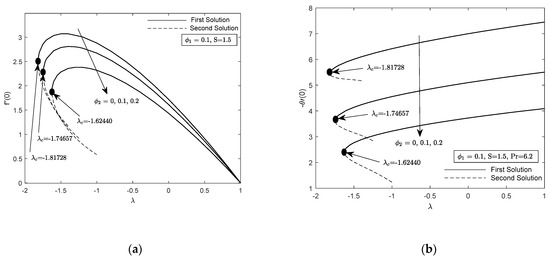
Figure 2.
Effect of on variation of (a) and (b) with
The different type of fluid is highlighted in Figure 3. Three types of fluid which were considered in this research were viscous , Al2O3/water , and Al2O3-TiO2/water . It can be clearly observed that the hybrid nanofluid was lower compared to viscous fluid and nanofluid. The flow moved up until a critical point, , where for viscous fluid, for Al2O3/water and for Al2O3-TiO2/water. In addition, the hybrid nanofluid was better in enhancing the separation of the boundary layer compared to viscous fluid and nanofluid. In our assumptions, the collision of two nanoparticles with different thermophysical properties is easily dissolved in the base fluid and consequently shortens the separation of the boundary layer. Furthermore, the thickness of the solution is widened for each of the fluids.
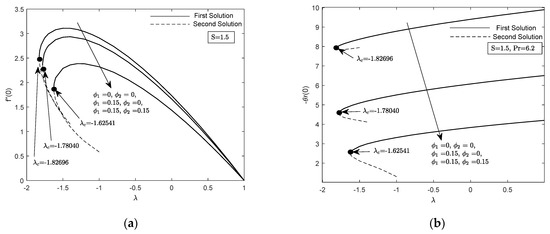
Figure 3.
Effect of different types of fluid on variation of (a) and (b) with
Figure 4 illustrates the effect of suction with λ. In action, a suction is used to improve the effectiveness of diffusers with high compression ratios (with large convergence angles) of the working fluid. The value of suction is increased by means of slowing down the early separation of the boundary layer. As we can see clearly, the value of the moving parameter, λ increases until a critical value, i.e., . When ; increases for and . Note that the duality of solution exists at for only a unique solution is seen and no solution is obtained beyond In addition, as S increases, the range of the solutions expands widely.
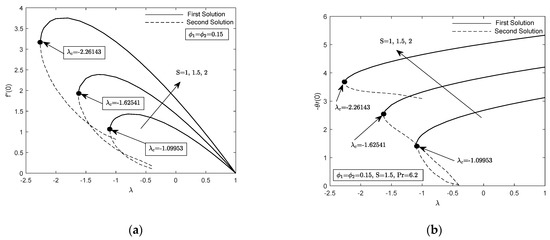
Figure 4.
Effect of values of S on variation of (a) f^″ (0) and (b) –θ^’ (0) with λ.
and for different are depicted in Figure 5. It is indicated in the figures that as the volume fraction or concentration of the nanoparticle in the hybrid nanofluid increases, the shear stress increases. However, an opposite trend in is observed; that is, decreases as in the base fluid increases. This is because has significant impacts on the thermal conductivity. The combination of Al2O3/TiO2 causes the nanoparticle molecules to collide with each other, consequently reducing the velocity and hence increasing the skin friction. The increased of in the base fluid results in lower thermal conductivity of the base fluid which reduces the heat enhancement capacity of the base fluid. This is due to the addition of nanoparticles, which raises the complex viscosity of the base fluid. It should also be stated that the thickness of the shear stress and thermal boundary layer also rises.
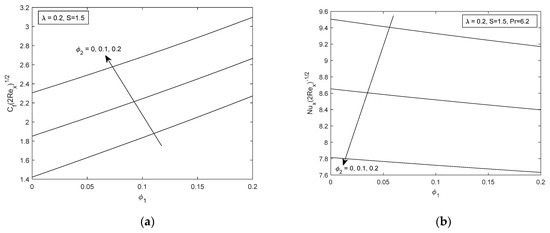
Figure 5.
Effect of on (a) and (b) with
Next, and for different S are shown in Figure 6. The increase of suction will increase the mass drawn away from the laminar boundary layer through the permeable walls. In addition, the increased value of S has a tendency to move the fluid to an unoccupied region that affects the surface limit. As a result, the shear stress on the surface increases with the increase of , and consequently generates heat in the fluid. As the heat increases, the temperature of the fluid increases to empower the flow of the fluid.
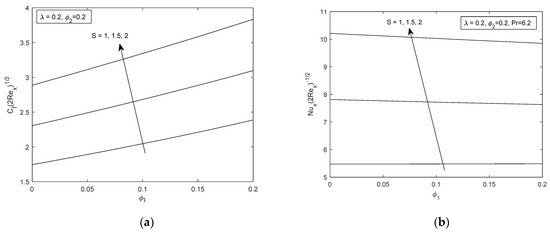
Figure 6.
Effect of S on (a) and (b) with
Figure 7, Figure 8 and Figure 9 portrayed the velocity profile, , and temperature profile, , for S, λ and . The following figures show that it asymptotically fulfills the boundary conditions for first and second solutions and consequently supports the graphical results described in Figure 1, Figure 2, Figure 3, Figure 4, Figure 5 and Figure 6. The velocity profile for the first solution decreases significantly while the second solution increases. Moreover, it can also be seen that the temperature profile increases in the first solution and decreases for the second solution with an increasing value for different λ and . As foreseen by other researchers, the second solution is thicker than the first solution.
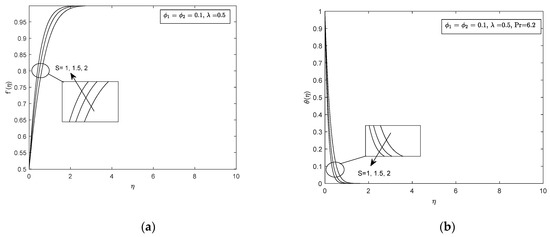
Figure 7.
(a) and (b) for various S.
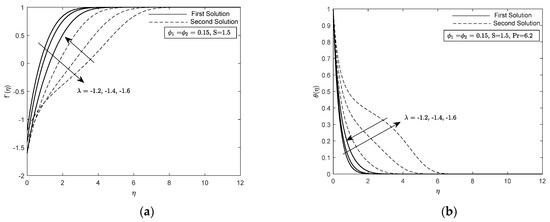
Figure 8.
(a) and (b) for various λ.
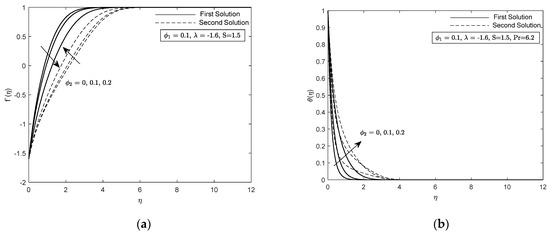
Figure 9.
(a) and (b) for various .
Since the numerical findings from bv4pc indicate that for certain values of λ there exist two solution branches, the first and second solutions, we substituted the system of linearized equations of Equations (17)–(19) with the BCs and new BC into bvp4c in MATLAB. Our intention of running this stability test was to find the minimum eigenvalues γ. The minimum eigenvalues for different and λ are tabulated in Table 4. It is worth observing that as the smallest eigenvalues approximate to zero. Therefore, the positive minimum value changed signs for the first solution to a negative minimum value for the second solution, which we indicate as a turning point. The first solution appeared to be positive, which is in good agreement with other researchers and indicates that the flow is stable and realizable. Meanwhile, the negative signs in the second solution specify the instability of the flow.

Table 4.
Least eigenvalues for selected λ.
5. Conclusions
This present study aims to analyze the effect of and S on skin friction and heat transfer. The method and results were successfully discussed. The conclusion can be summarized as a duality of solutions existing for certain ranges of , S and moving parameter, λ. It is worth mentioning that the presence of the duality solutions is initiated when the flow moves in a different direction compared to the plate. In addition, the range of the solutions widens when the value of S increases and narrows as the value of increases. Throughout the test on stability, the first solution is said to be a stable solution compared to the second solution. As illustrated in Figure 3, the hybrid nanofluid shows that the separation of boundary layer occurs quicker compared to ordinary fluid and nanofluid. It was found that an increasing value of S will increase and Meanwhile, it is also observed that the presence of in the fluid flow will lead to higher and lower ; the physical cause is the rapid collision and motion between the nanoparticles of different thermophysical properties. By using the hybrid nanofluid, we can increase and reduce . This knowledge is useful for scientists and engineers.
Author Contributions
N.A.L.A. and N.B. designed the research; N.A.L.A. designed the methodology framework of the problem and conducted the numerical result using bvp4c MATLAB, N.B. investigated and validated on the numerical result obtained, N.A.L.A. writing the original draft, N.B. then reviewed, edited and approved the manuscript. All authors have read and agreed to the published version of the manuscript.
Funding
This research received financial assistance funded from Fundamental Research Grant Scheme (FRGS/1/2018/STG06/UPM/02/4/5540155) from Ministry of Higher Education Malaysia.
Acknowledgments
The authors would like to express their deeply gratitude to the reviewers for all their meticulous, supportive also valuable comments and suggestions for this manuscript. Also, to scholarship leave received from Ministry of Higher Education Malaysia and MATLAB 2019a license from Universiti Pertahanan Nasional Malaysia.
Conflicts of Interest
The authors declare no conflict of interest.
Abbreviations
| ODE | Ordinary Differential Equation |
| Pr | Prandtl number |
| T | Temperature |
| U | Uniform free stream |
| S | Suction/injection parameter |
| Plate heat flux | |
| Nux | Local Nusselt number |
| Rex | Reynolds number |
| Skin friction coefficient | |
| Condition on plate | |
| ∞ | Ambient condition |
| hnf | Hybrid nanofluid |
| nf | Nanofluid |
| f | Fluid |
| α | Thermal diffusivity |
| μ | Dynamic viscosity |
| ρ | Density |
| ψ | Stream function |
| η | Similarity variables |
| θ | Dimensionless temperature |
| (ρCp)f | Specific heat for base fluid |
| Cp | Specific heat at constant pressure |
| τ | Dimensionless time |
| k | Thermal conductivity |
| Concentration of nanoparticles | |
| ϒ | Eigenvalues |
| υ | Kinematic viscosity |
References
- Busemann, A. Ludwig Prandtl. 1875–1953. Biogr. Mem. Fellows R. Soc. 1960, 5, 193–205. [Google Scholar]
- Duwairi, H.M.; Tashtoush, B.; Damseh, R.A. On heat transfer effects of a viscous fluid squeezed and extended between two parallel plates. Heat Mass Transf. 2004, 41, 112–117. [Google Scholar]
- Arifuzzaman, S.M.; Islam, M.M.; Haque, M.M. Combined heat and mass transfer steady flow of a viscous over a vertical plate with large suction. Int. J. Sci. Technol. Soc. 2015, 3, 236–242. [Google Scholar] [CrossRef]
- Liu, X.; Zheng, L.; Chen, G.; Ma, L. Coupling effects of viscous sheet and ambient fluid on boundary layer flow and heat transfer in Power law fluids. J. Heat Transf. 2019, 141, 061701. [Google Scholar] [CrossRef]
- Anyanwu, O.E.; Raymond, D.; Adamu, A.K.; Ogwumu, O.D. Viscous and Joule dissipation effects on heat transfer in MHD Poiseuille flow in the presence of radial magnetic field. FUW Trends Sci. Technol. J. 2017, 2, 171–186. [Google Scholar]
- Venkateswarlu, M.; Kumar, M.P. Soret and heat source effects on MHD flow of a viscous fluid in a parallel porous plat channel in presence of slip condition. U.P.B Sci. Bull. Ser. D 2017, 79, 171–186. [Google Scholar]
- Raju, K.C.; Reddy, D.B.S. Effect of chemical reaction, thermo-diffusion, hall effects on MHD convective heat and mass transfer flow of a viscous fluid in a vertical channel bounded by stretching and stationary walls. Int. J. Sci. Innov. Math. Res. 2019, 7, 12–24. [Google Scholar]
- Kakaç, S.; Pramuanjaroenkij, A. Review of convective heat transfer enhancement with nanofluids. Int. J. Heat Mass Transf. 2009, 52, 3187–3196. [Google Scholar] [CrossRef]
- Masuda, H.; Ebata, A.; Teramae, K.; Hishinuma, N. Alteration of thermal conductivity and viscosity of liquid by dispersing ultra-fine particles. Netsu Bussei 1993, 7, 227–233. [Google Scholar] [CrossRef]
- Choi, S.U.S. Enhancing Thermal Conductivity of Fluids with Nanoparticles. In Developments and Applications of Non-Newtonian Flows; Siginer, D.A., Wang, H.P., Eds.; ASME: New York, NY, USA, 1995; Volume 66, pp. 99–105. [Google Scholar]
- Choi, S.U.S.; Zhang, Z.G.; Yu, W.; Lockwood, F.E.; Grulke, E.E. Anomalously thermal conductivity enhancement in nanotube suspension. Appl. Phys. Lett. 2001, 79, 2252–2254. [Google Scholar] [CrossRef]
- Long, N.M.A.N.; Suali, M.; Ishak, A.; Bachok, N.; Arifin, N.M. Unsteady stagnation point flow and heat transfer over stretching/shrinking sheet. Appl. Sci. 2011, 11, 3520–3524. [Google Scholar]
- Mohyud-Din, S.T.; Zaidi, Z.A.; Khan, U.; Ahmed, N. On heat and mass transfer analysis of a nanofluid between rotating plates. Aerosp. Sci. Technol. 2015, 46, 514–522. [Google Scholar] [CrossRef]
- Zhu, J.; Chu, P.; Sui, J. Exact analytical nanofluid flow and heat transfer involving asymmetric wall heat fluxes with nonlinear velocity slip. Math. Probl. Eng. 2018, 2018. [Google Scholar] [CrossRef]
- Bakar, N.A.A.; Bachok, N.; Arifin, N.M. Boundary layer stagnation-point flow over a stretching/shrinking cylinder in a nanofluid: A stability analysis. Indian J. Pure Appl. Phys. 2019, 57, 106–117. [Google Scholar]
- Mishra, S.R.; Baag, S.; Bhatti, M.M. Study of heat and mass transfer on MHD Walters B nanofluid flow induced by stretching plate surface. Alex. Eng. J. 2018, 57, 2435–2443. [Google Scholar] [CrossRef]
- Prasad, P.D.; Kumar, R.V.M.S.S.K.; Varma, S.V.K. Heat and mass transfer analysis for the MHD flow of a nanofluid with radiation absorption. Ain Shams Eng. J. 2018, 9, 801–813. [Google Scholar] [CrossRef]
- Farooq, M.; Ahmad, S.; Javed, M.; Anjum, A. Melting heat transfer in squeezed nanofluid flow through Darcy Forchheimer medium. J. Heat Transf. 2019, 141, 012402. [Google Scholar] [CrossRef]
- He, W.; Tongraie, D.; Lotfipour, A.; Purfattah, F.; Karimipour, A.; Afrand, M. Effect of twisted tape inserts and nanofluid on flow field and heat transfer characteristics in a tube. Commun. Heat Mass Transf. 2020, 110, 104440. [Google Scholar] [CrossRef]
- Sakiadis, B.C. Boundary layer behavior on continuous solid surfaces II. The boundary layer on a continuous flat surface. AIChE J. 1961, 7, 221–225. [Google Scholar]
- Blasius, H. Grenzschichten in Flüssigkeiten mit kleiner Reibung. Z. Angew. Math. Phys. 1908, 56, 1–37. [Google Scholar]
- Tsou, F.K.; Sparrow, E.M.; Goldstein, R.J. Flow and heat transfer in the boundary layer on a continuous moving surface. Int. J. Heat Mass Transf. 1967, 10, 219–235. [Google Scholar] [CrossRef]
- Tsai, S.-Y.; Hsu, T.H. Thermal transport of a continuous moving plate in a non-Newtonian fluid. Comput. Math. Appl. 1995, 29, 99–108. [Google Scholar] [CrossRef]
- Bataller, R.C. Radiation Effects in the Blasius Flow. Appl. Math. Comput. 2008, 198, 333–338. [Google Scholar]
- Haile, E.; Shankar, B. Boundary layer flow of nanofluids over a moving surface in the presence of thermal radiation, viscous dissipation and chemical reaction. Appl. Appl. Math. 2015, 10, 952–969. [Google Scholar]
- Maliki, H.; Safaei, M.R.; Togun, H.; Dahari, M. Heat transfer and fluid flow of pseudo-plastic nanofluid over a moving permeable plate with viscous dissipation and heat absorption/generation. J. Therm. Anal. Calorim. 2019, 135, 1643–1654. [Google Scholar] [CrossRef]
- Hartnett, J.P. Mass transfer cooling. In Handbook of Heat Transfer Applications, 2nd ed.; McGraw-Hill: New York, NY, USA, 1985; pp. 1–111. [Google Scholar]
- Masad, J.A.; Nayfeh, A.H. Effects of suction and wall shaping on the fundamental parametric resonance in boundary layers. Phys. Fluids A Fluid Dyn. 1992, 4, 963–974. [Google Scholar] [CrossRef]
- Rosali, H.; Ishak, A.; Pop, I. Micropolar fluid flow towards stretching/shrinking sheet in a porous medium with suction. Int. Commun. Heat Mass Transf. 2012, 39, 826–829. [Google Scholar] [CrossRef]
- Pandey, A.K.; Kumar, M. Effects of viscous dissipation and suction/injection on MHD nanofluid flow over a wedge with porous medium and slip. Alex. Eng. J. 2016, 55, 3115–3123. [Google Scholar] [CrossRef]
- Subamowo, G.M.; Akinshilo, A.; Yinusa, A.A. Two-dimensional flow analysis of nanofluid through porous channel with suction/injection at slowly expanding/contracting walls using variation of parameter method. Transp. Phenom. Nano Micro Scales 2019, 7, 120–129. [Google Scholar]
- Lund, L.A.; Omar, Z.; Khan, U.; Khan, I.; Baleanu, D.; Nisar, K.S. Stability Analysis and Dual Solutions of Micropolar Nanofluid over the Inclined Stretching/Shrinking Surface with Convective Boundary Condition. Symmetry 2020, 12, 74. [Google Scholar] [CrossRef]
- Kausar, M.S.; Hussanan, A.; Mamat, A.; Ahmad, B. Boundary Layer Flow through Darcy–Brinkman Porous Medium in the Presence of Slip Effects and Porous Dissipation. Symmetry 2019, 11, 659. [Google Scholar] [CrossRef]
- Olatundun, A.T.; Makinde, O.D. Analysis of Blasius flow of hybrid nanofluids over a convectively heated surface. Defect Diffus. Forum 2017, 377, 29–41. [Google Scholar] [CrossRef]
- Waini, I.; Ishak, A.; Pop, I. Hybrid nanofluid flow and heat transfer over a nonlinear permeable stretching/shrinking surface. Int. J. Numer. Methods Heat Fluid Flow 2019, 29, 3110–3127. [Google Scholar] [CrossRef]
- Bachok, N.; Ishak, A.; Pop, I. Boundary layer flow over a moving surface in nanofluid with suction/injection. Acta Mech. Sin. 2012, 28, 34–40. [Google Scholar] [CrossRef]
- Ahmed, M.S.; Mimi, E.A. Effect of hybrid and single nanofluids on the performance characteristics of chilled water air conditioning system. Appl. Therm. Eng. 2019, 163, 114398. [Google Scholar] [CrossRef]
- Oztop, H.F.; Abu-Nada, E. Numerical study of natural convection in partially heated rectangular enclosure filled with nanofluids. Int. J. Heat Fluid Flow 2008, 29, 1326–1336. [Google Scholar] [CrossRef]
- Devi, S.P.A.; Devi, S.S.U. Numerical investigation of hydromagnetic hybrid Cu-Al2O3/water nanofluid flow over a permeable stretching sheet with suction. Int. J. Nonlinear Sci. Numer. Simul. 2016, 17, 249–257. [Google Scholar] [CrossRef]
- Weidman, P.D.; Kubitschek, D.G. The effect of transpiration on self-similar boundary layer flow over moving surfaces. Int J. Eng. Sci. 2006, 44, 730–737. [Google Scholar] [CrossRef]
- Merkin, J.H. On dual solutions occurring in mixed convection in a porous medium. J. Eng. Math. 1985, 20, 171–179. [Google Scholar] [CrossRef]
- Harris, S.D.; Ingham, D.B.; Pop, I. Mixed convection boundary layer flow near the stagnation point on a vertical surface in porous medium: Brinkman model with slip. Transp. Porous Media 2009, 77, 267–285. [Google Scholar] [CrossRef]
- Shampine, L.F.; Gladwell, I.; Thomson, S. Solving ODEs with MATLAB; Cambridge University Press: Cambridge, UK, 2003. [Google Scholar]
© 2020 by the authors. Licensee MDPI, Basel, Switzerland. This article is an open access article distributed under the terms and conditions of the Creative Commons Attribution (CC BY) license (http://creativecommons.org/licenses/by/4.0/).